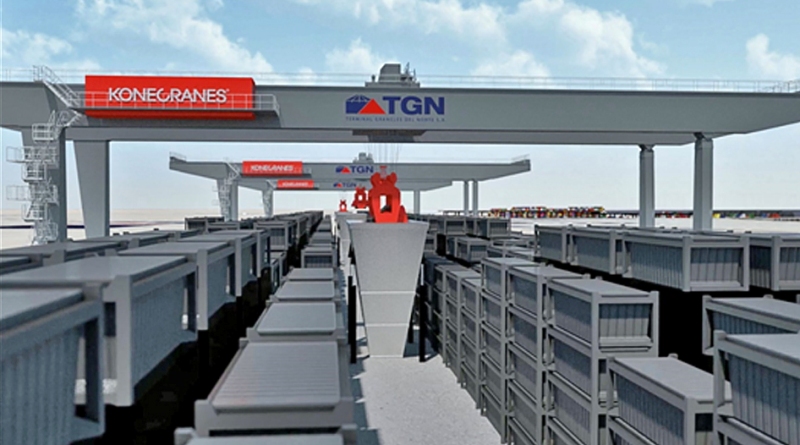The TBA Group provided consultancy services to Terminal Graneles del Norte SA (TGN) of Puerto Angamos in Chile for its new containerised bulk terminal.

The terminal will use automated Konecranes RMGs in the yard to receive and unload bulk containers of copper concentrate, using RAM revolver container rotators to unload the cargo into hoppers under the RMGs. The hoppers will feed a conventional belt conveyor and shiploader system.
TBA has now provided information on its role in the project, and in particular its part in validating the target terminal capacity and the decision to use a containerised bulk system in an automated yard paired with conveyors and a shiploader to deliver a system capable of supporting an annual throughput of 4 Mtpa.
Most terminals using containerised bulk handling systems unloaded the cargo directly into the vessel using a container rotator on a mobile harbour crane, or an STS gantry crane in some cases.
Bernardo Sedini, terminal manager of TGN, said that its customer was looking for an improved process. “Two years ago, TGN was awarded with a tender to build a new terminal to load copper concentrates,” he said. “Today, we load them through Puerto Angamos and our main customer is a state-owned company which is the first producer of copper in the world.

A belt shiploader fed by a conveyor provides faster, more consistent shiploading
“They wanted to modernise the way they loaded, so they tendered this new terminal with a 25-year contract. They wanted to load through a conveyor belt and a shiploader, because this brings a lot of benefits for them as a customer.
It’s faster, so lower turn time for the vessels and then the fact that you’re moving the cargo through a conveyor, offers them some other benefits in terms of weighing, sampling, and many things that you can do when you load continuously and not on a box-to-box basis.”
In March 2020, TBA was contracted to review and simulate the master plan, which initially involved automated horizontal transport using terminal tractors to move containers from the yard to overhead cranes operating over hoppers, which feed a conventional belt conveyor shiploader system. This is the method used at another bulk terminal in Mejillones.
“Defining the right amount of equipment was very critical, so we asked for this simulation from TBA,” Sedini said. “We have asked from other providers as well, but TBA has this consultant view where they question everything, and they investigate it, and they try to get to the bottom of the problem and see what the real trouble is and how to work around it. The discussions that we had, were very well defined and supported my decision-making as the terminal manager.”
TBA came up with a new solution, using automated RMGs to handle the containers and feed a conventional belt shiploader, as TBA explains: “After reviewing the master plan, TBA proposed a more efficient performing system for the new automated copper concentrate cargo handling operation which were derived from the simulated detailed storage/handling strategies.
“The new operations entail rail and road container transportation and vessel load by shiploader for bulk operations, instead of using the existing solution of MHC with a revolver spreader, to increase the terminal’s performance.
“The solution integrates containerised and bulk operations by moving the revolver operation from the quay crane to the yard handling equipment [RMG]. By implementing a conveyor-shiploader system for the bulk loading vessel operations, the horizontal transportation by terminal tractors is eliminated.
“This alternative ensures a higher and constant performance from conveyor belt, and it will bring reduction in CO2 emissions from the diesel truck fleet, requires less maintenance, and reduces the risk of accidents. By using advanced simulation to validate different scenarios, the best improvement for the yard and handling strategy resulted in an over 40% expected increase on performance.”
Automated material handling systems are typically associated with higher volume facilities, but Bernardo said South American terminals want to implement the same technology on a smaller scale.
He explained: “We’re always looking at new things. South America is very behind in automation, very behind in adopting technologies. We’re not going to get to those volumes – for instance like to the US or Europe. But we do want to get to that technology on a smaller scale as we have the resources. We have the team and we have the need.”




